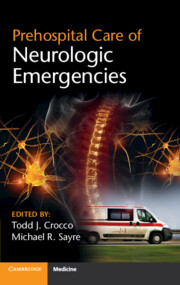
- Publisher:
- Cambridge University Press
- Online publication date:
- August 2014
- Print publication year:
- 2014
- Online ISBN:
- 9781139629058

Prehospital Care of Neurologic Emergencies is a reliable and definitive resource for emergency medical services personnel at multiple levels: physicians, paramedics, nurses and others who encounter these critically ill patients. This focused and succinct book addresses the management of a wide range of neurologic emergencies, including traumatic brain injuries, spinal cord injuries, strokes, and seizures. In these emergencies time is critical, and the simply presented, straightforward format of the patient care and management recommendations help readers to treat patients rapidly and confidently. Each chapter follows a standard format that includes an overview of each neurologic emergency, important background, key challenges, and areas requiring future investigation. This book is unlikely to be placed on your bookshelf; instead, you will keep it nearby for times when you face life-threatening neurologic emergencies. When seconds count, this book has the answers.
 Loading metrics...
Loading metrics...
* Views captured on Cambridge Core between #date#. This data will be updated every 24 hours.
Usage data cannot currently be displayed.